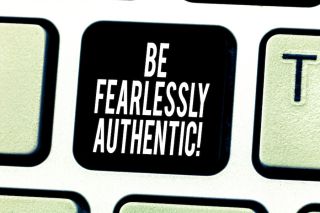Authenticity
Fearlessness and Authenticity
Cultivating fearlessness and authenticity supports a rich and vital life.
Posted May 7, 2024 Reviewed by Monica Vilhauer
Key points
- Fearlessness is essential for being authentic in our relationships with others and ourselves.
- Fearlessness rests on the capacity to resist habitual conformity to the life-scripts of others.
- Recognizing our values and feelings calls for fearless self-reflection.
"You gain strength, courage and confidence by every experience in which you really stop to look fear in the face.”– Eleanor Roosevelt
Fearlessness in our relationships is essential if we are to live our lives in a way that is consistent with who we are, what we value, and who we wish to be. Fearlessness makes room for us to be more authentic with ourselves and others. As such, fearlessness is essential for trusting ourselves in the creative process, including the creative process of how we choose to shape our lives.
Of course, being fearless and authentic requires that we give ourselves the freedom to be vulnerable. All too often, with and without awareness, we live our lives constricted by our needs for approval, acceptance, inclusion, and a fear of rejection—as if by revealing our truths, we will forever be abandoned by an individual or the pack. Fearlessness rests on the capacity to resist the pressure to adapt to the expectations and beliefs of others, not in a destructive manner built on being reactive, but rather as an outgrowth of respecting and honoring our uniqueness.
Being fearless and authentic in relationships brings about a deeper and more real connection with coworkers, friends, family, significant others, and ourselves. This connection results from hearing our truths spoken out loud, which helps us to identify which relationships are truly meaningful.
By being fearlessly authentic, we will immediately recognize the extent to which others can be authentic as well. Watch their response. Are they genuinely listening? Do they squirm and shift the topic? Do they respond in a way that minimizes our ideas or feelings? Our being fearless and authentic can offer others a safe place that supports their fearlessness, or it may create discomfort for some.
Embracing our authenticity requires recognizing our values and feelings, which calls for a certain degree of fearlessness. It requires openness to our inner landscape and acceptance of whatever we find when we explore it. This is no easy task.
By contrast, avoiding our authenticity invariably leads to a sense of isolation and alienation from others and ourselves. This then evokes feelings of invisibility in our relationships. Not knowing ourselves also leaves us more reactive to the scripts of others—whether or not we consciously or unconsciously embrace them. This can often lead to resentment and withdrawal accompanied by the conclusion that relationships offer conflict and little satisfaction.

Challenges to being fearless and authentic
Becoming more fearless in our relationships can be cultivated by overcoming specific challenges to being authentic. These challenges might include:
1. Feeling that our feelings or desires are less relevant than those of others.
Some of us have internalized beliefs that the needs of others should always come first. As such, we may feel selfish when addressing the satisfaction of our needs. Any attempt to do so may be fraught with tension related to guilt or even shame.
2. Confusion over what it is we feel or desire.
Much of who we are lies below our awareness. As such, a lack of self-knowledge fosters a lack of connection with ourselves. Historically ignoring our thoughts and feelings in turn leads to confusion over what we feel and value. Additionally, living our lives primarily according to the scripts of others further contributes to our lack of self-awareness.
3. Fear of disapproval or even abandonment.
Some of us may have an inherent fear of rejection or even abandonment if we reveal what we truly feel or believe. Consequently, we may be extremely conflict avoidant, fearing that stating our feelings or thoughts may inevitably lead to discord and tension.
4. A lack of skills in being assertive in communication.
Self-expression can take many forms. Some of us have learned skills in being assertive while others have not had models for such expression. We may consequently fear coming across as being too demanding, too angry or too overbearing.
Strategies for enhancing fearlessness and authenticity
The good news is that we can become more fearless and authentic in our relationships. The following strategies can be highly effective in this endeavor.
1. Become aware of your specific challenges to being more fearless.
2. Distinguish between your being sensitive to feeling threatened and whether you are facing a real threat.
3. When you think about voicing your perspective, imagine how you might feel if your friend, relative or partner presented his or her views in the same manner.
4. Engage in practices of self-compassion that expand your mindfulness, your acceptance of your humanity, and help you to remember that we all suffer.
5. Learn skills in assertive communication—expression that is neither passive nor aggressive that emphasizes how you are impacted as well as your perspective. For example, “When you did that, I felt___” “I would like____”
6. Begin being more assertive with regard to less threatening situations, i.e.; voicing your choice of restaurant or movie to attend. Start your practice with those whom you most trust. Then build upon your experiences to bolster your fearlessness.
7. Envision yourself in your 90’s telling a good friend “I spent most of my life afraid to be myself.” (This is in fact one of the most frequently cited regrets voiced by those reaching the end of their lives.)
8. Associate with others who similarly value fearlessness and authenticity.
A history of being fearful may lead you to feel somewhat anxious and uncomfortable in your initial attempts to be more fearless. As it is with any new challenge, that initial fear will diminish with practice, patience, and commitment to change.
Fearlessness takes time to cultivate. Like strengthening a muscle that’s not been challenged, it will feel especially uncomfortable in the beginning. Becoming more fearless may mean allowing yourself to be more authentic while still being fearful when doing so. This makes perfect sense. You’re pushing yourself into unfamiliar territory beyond your comfort zone, whether it’s in voicing your opinion out loud or in writing, or sufficiently trusting yourself to focus on your inner visualization to form a painting, drawing, or sculpture. These examples all reflect the anxiety of creativity and trusting yourself to access and express your authentic self.
Savor those moments when you have pushed yourself to be fearless. Visualize the situation—the setting, the people involved, the sounds, any scents, and the sensations in your body that accompanied those positive aspects of having pushed yourself beyond what you’ve become accustomed to think of as yourself.
As psychoanalyst Rollo May emphasized, changing habits calls for evoking and asserting our will, from wherever we can find it. Your will might be supported by your past experiences of feeling rewarded by your fearlessness, by an informed optimistic attitude, by envisioning your future self, or by any form of faith.
Fearless authenticity calls for opening your heart to life and to connection with others. And in the process, you will bring greater richness and vitality into your life.




